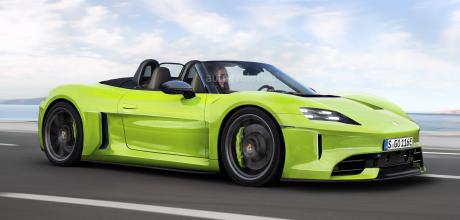Porsche’s next EVs - New-era electric Boxster 983
Fifth-gen Boxster breaks cover as mid-engined' EV. Electric-only successors to 718 pair set to mimic ICE models’ legendary dynamics
he electric successors to the wildly successful Porsche 718 Cayman and Boxster are due by the middle of the decade as rapid and keen-handling third entries into Stuttgart's expanding EV line-up.
The 983-generation pair — set to be launched exclusively with electric power — will adopt a bespoke sports car platform designed to mimic the current ICE models' mid-engined characters. This architecture will be separate from both the J1 platform used by today’s Taycan EV and the PPE platform being pioneered by the 2024 Macan EV (see opposite). The fifth-generation Boxster now looks to have begun testing on public roads with production-ready styling at the front and rear. There are no obvious giveaways to a zero-emission powertrain, but Autocar's spies say the cabriolet's exhaust outlet is a red herring, while the visible headlights and rear light bar are designs shared with the Taycan and upcoming Macan EV.
Beyond that, it is difficult to gauge just how different the electric Boxster will be from today’s petrol-powered proposition. Porsche’s earlier Mission R concept gave clues to the company’s plans for
electric sports cars, and indeed the lighting details seen here bear a resemblance to that car. However, the side profile is much closer to that of the current Boxster, which has been on sale since 2016.
Porsche declined to comment on the pictures, but with a projected launch in two to three years, it is reasonable to suggest that test mules would be hitting public roads at around this time.
The company is aiming for pure EVs to account for 50% of its global sales in 2025 and 80% of sales in 2030, and it is also readying electric equivalents to the Panamera and Cayenne — each sitting on Porsche’s own ‘SSP Sports’ platform — as well as a second- generation Taycan and a new flagship luxury SUV to crown the line-up. The 911 will be the final Porsche model to ditch a combustion engine, with
Stuttgart citing an awareness of the emotional weight attached to its rear-mounted flat-six engine and unique handling behaviour.
The Boxster and Cayman, Porsche’s entry-level sports EVs, will use a novel battery arrangement called the ‘e-core’ layout and offer as low a seating position and centre of gravity as possible, in line with their dynamic billing.
Porsche used a reworked version of the 718 Cayman chassis to make the Mission
R concept, which has since spawned the1072bhp Cayman GT4 E-Performance prototype, but when asked about a possible production version at its unveiling, company boss Oliver Blume said: “When we electrify a model, we won't do a carryover of the combustion engine [platform] because there are too many compromises.
The Mission R is designed tv mimic a mid-engined sports car by placing the heavy battery pack behind the driver but ahead of the rear axle, where the engine would usually lie. The design also aids the weight distribution and balance, especially with the Mission R concept’s two electric motors — one on each axle — being biased towards rear-driven power.
Porsche's electric Boxster and Cayman will be among the first mainstream two-seat sports EVs to market. Lotus and Alpine will follow a year later with similarly conceived follow-ups to the Emira and A110 respectively, and Toyota has hinted at plans for an electric successor to the MR-2 roadster. Before
that, MG is poised to reveal the production version of its radical Cyberster sports roadster concept for a 2024 launch, while niche German brand Wiesmann is well advanced with the development of its 671bhp Project Thunderball drop-top.


